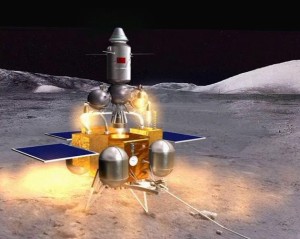For the first time, the Moon’s far side will be on the receiving end of a robotic lunar lander – China’s Chang’e-4.
Zhao Xiaojin, secretary of the CPC (Communist Party of China) committee at the China Aerospace Science and Technology (CAST), explains that the two-phase Chang’e-4 mission is being readied for launch in the first and second half of this year.
Relay satellite
“In the first half of 2018, we will first launch a relay satellite to Lagrange L2 Point, where the satellite can keep communication with both the far side of the Moon and the Earth. Therefore, we can control the lunar probe for data transmission using this relay satellite,” Zhao told China Central Television (CCTV) earlier this month.
Launch of the far side Chang’e-4 lunar lander is slated for the second half of 2018. It will not only do a soft landing on the far side of the Moon, “but also conduct in-situ and patrol exploration at the landing site,” Zhao said.
Steep and vertical landing
China’s Chang’e-4 lunar probe was the backup of the Chang’e-3 lunar probe which successfully landed on Moon in 2013, dispatching a lunar rover.
Zhao told CCTV that the landing mode and working condition of the Chang’e-4 lunar probe are very different from the Chang’e-3 lunar probe.
“Chang’e-3 lunar probe used a slow and arc-shaped landing, while as for Chang’e-4 lunar probe we have to adopt a steep and almost vertical landing,” Zhao explained. “Chang’e-4 lunar probe will have huge improvements on its capabilities because we have adopted new technologies and new products. For example, Chang’e-3 lunar probe could not work during the night, but Chang’e-4 lunar probe can do some measurement work at night,” Zhao added.
Track record
The Chang´e-3, named after a Chinese lunar goddess, was China’s first spacecraft to make a soft landing on the Moon. It consisted of a lander and a moon rover called “Yutu” (Jade Rabbit).
The Chang´e-3 mission was labeled as the second phase of China´s lunar program, which includes orbiting, landing and returning to Earth lunar samples. It follows the success of the Chang´e-1 and Chang´e-2 missions in 2007 and 2010.
Exploration of polar regions
Last year, Pei Zhaoyu, deputy director of the Lunar Exploration and Space Program Center with the China National Space Administration (CNSA) told attendees at the 7th IAA-CSA Conference on Advanced Space Technology that China will implement three missions in the polar regions of the Moon and set up scientific research stations there to offer a platform for future lunar probes.
“We will carry out three missions at the Moon’s polar regions to research the geological structure and mineral composition of its south pole and we will take samples back from the Moon during one of these missions. By building scientific research stations on the Moon, we want to provide a platform for larger scale and more rich lunar probe activities in the future,” Pei told CCTV.
Sample return
China’s blossoming robotic Moon exploration agenda did suffer a setback last year due to a July launch failure of the country’s most powerful rocket on its second flight, the Long March 5. That heavy-lifter is needed to hurl China’s Moon sampling and return to Earth mission.
For more information on the repercussions of that booster issue, go to:
China’s Delayed Moon Mission Sparks Debate over Lunar Samples
The Chang’e 5 spacecraft could return invaluable new moon rocks to Earth, but who will get to study them?
Also, go this Gallery Military video on the Chang’e-4 mission:






Utterly composed written content , regards for selective information .